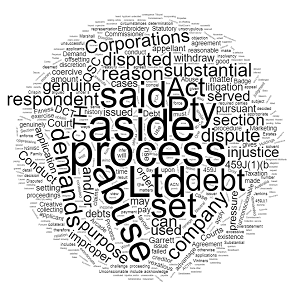Table of Contents
Toggle
Abuse of Process – Statutory Demand in Australia
When is a statutory demand an abuse of process?
The Courts have said that an abuse of process includes:
- Conduct that is unconscionable; and/or
- Conduct which gives rise to substantial injustice; and/or
- When they are used for an improper purpose; and/or
- When they are used for the coercive collecting of debt genuinely disputed.
If you have been served with a statutory demand for an improper purpose, or you are clearly solvent, or the issuer has ignored your claims of genuine dispute or offsetting claims, then this could be an abuse of process.
If the issue of a statutory demand is deemed to be for an improper purpose, then the company can apply to set the demand aside for some other reason pursuant to section 459J of the Corporations Act 2001 (CTH).
What is a statutory demand?
A statutory demand is a demand for money made to a company under section 459E of the Corporations Act 2001 (CTH).
The debt must be more than $4,000.00 being the statutory minimum, and must be made by a creditor for a debt which is due and payable at the time of issuance.
There must also not be a genuine dispute as the existence or quantum of the debt, or any genuine offsetting claims.
Setting Aside a Statutory Demand
If you have been served with a statutory demand, there are a number of ways in which a demand can be set aside, these include:
- You have a genuine dispute; and/or
- You have an offsetting claim; and/or
- The statutory demand is defective causing substantial injustice; and/or
- Some other reason (such as an abuse of process).
This article will detail what the cases have said in relation to an abuse of process, and detail when statutory demands have been successfully set aside pursuant to section 459J of the Corporations Act 2001 (CTH) because of this abuse of process.
Section 459J(1) of the Corporations Act 2001 (CTH)
Section 459J(1) of the Corporations Act 2001 (CTH) says:
(1) On an application under section 459G, the Court may by order set aside the demand if it is satisfied that:
(a) because of a defect in the demand, substantial injustice will be caused unless the demand is set aside; or
(b) there is some other reason why the demand should be set aside.
Pursuant to 459J(1)(b), the Courts have set aside statutory demands for some other reason, based on the reason being an abuse of process.
What is an Abuse of Process
The Courts have said that an abuse of process includes:
- Conduct that is unconscionable; and/or
- Conduct which gives rise to substantial injustice; and/or
- When they are used for an improper purpose; and/or
- When they are used for the coercive collecting of debt genuinely disputed.
The above terms have been given by the Courts in a number of different cases and upheld in subsequent cases.
Abuse of Process – Conduct that is Unconscionable
In Hoare Bros Pty Ltd v Commissioner of Taxation (1996) 62 FCR 302 Black CJ, Einfeld and Sackville JJ said:
In the present case, Olney J implied that he would have been prepared to exercise the discretion in the company’s favour, had it been shown that the Commissioner’s conduct was unconscionable, was an abuse of process, or had given rise to substantial injustice.
Unconscionable is defined in the dictionary as:
not guided by conscience; unscrupulous.
not in accordance with what is just or reasonable.
excessive; extortionate.
So, conduct which is unscrupulous, excessive, unjust, unreasonable, or extortionate may be argued in an application setting aside a statutory demand.
Abuse of Process – Conduct which gives rise to Substantial Injustice
In Arcade Badge Embroidery Co Pty Ltd v DCT (2005) 157 ACTR 22 Crispin P, Gray and Marshall JJ said:
Where the respondent has failed to make good its representation that it would withdraw the statutory demand, it is appropriate that we exercise our discretion in favour of the appellant. In so doing, we acknowledge that a substantial injustice would otherwise arise as a result of the respondent being able to renege on its agreement with the appellant to withdraw the statutory demand.
So substantial injustice may be argued to in an application setting aside a statutory demand. Although not required, unlike section 459J(1)(a) of the Corporations Act 2001 (CTH) it can still be a factor.
Abuse of Process – Coercive Collecting of Debt
In Owners Corp SP66609 v Perpetual Trustee Co Ltd [2010] NSWSC 497 Palmer J said:
[t]he Statutory Demand process is not to be used for the coercive collecting of disputed debts from solvent companies … [t]he creditor should save its time and money by eschewing statutory demand litigation and commencing debt recovery proceedings immediately.
The statutory demand procedure should not be used to pressure or coerce a person into paying a disputed amount.
Examples of Abuse of Process
The below are cases which allowed the setting aside of statutory demands under section 459J(1)(b) of the Corporations Act 2001 (CTH) because of this abuse of process.
Debts Challenged in Other Jurisdictions
In the matters of Neutral Bay Pty Ltd v. Deputy Commissioner of Taxation; MA Howard Racing Pty Ltd v DCT ; Neutral Bay (Sales) Pty Ltd v DCT ; Broadbeach Properties Pty Ltd v DCT [2006] QSC 394 the applications to set aside the demands were successful because each of the debts which are demanded is challenged by the applicants in proceedings in the Administrative Appeals Tribunal under Pt IVC of the Taxation and Administration Act 1953 (Cth) or was subject to an outstanding objection. Philip McMurdo J said:
The applicants have in each case established that there is good reason for setting aside these demands under s 459J, in so far as they are not already to be varied under s 459H. There is an unfairness in the use of the statutory demand procedure in these cases because of its likely impact upon the taxpayer’s objection or challenge to what the respondent has decided it should pay.
A similar matter was heard in Softex Industries Pty Ltd, Re [2001] QSC 377 where Mullins J said:
In the circumstances of the history of the applicant’s challenge to the inclusion in its income of the sum of $6,791,916 which it received under TAPS and the issue of the statutory demand by the respondent to include the disputed income tax when the AAT decision relating to the same had been reserved since November 2000, it was oppressive for the respondent to serve a statutory demand incorporating that disputed sum. On this basis alone, the statutory demand should be set aside.
In Ralph Lauren 57 Pty Ltd v Conley [2015] QSC 90 the debts related to a Family Court matter and the debts were contested and undecided in that jurisdiction. The Applicant said that:
(1) the matter of each statutory demand is the subject of contested litigation in the Family Court proceeding;
(2) there is no suggestion that the applicant cannot pay its debts and it may therefore be inferred that the statutory demands were not served for the purposes for which Part 5.4 of the Act was intended; and
(3) in the circumstances, service of the statutory demands was vexatious, oppressive and constituted an abuse of process.
Douglas J said:
The consequence is that the applications to set aside the statutory demands should be granted
Inducement to Enter into an Agreement
In Ri-Co Holdings (Australia) Pty Ltd v. Allied Sandblasters Pty Ltd; Ri-Co Holdings (Australia) Pty Ltd v Beutel [2009] QSC 122 it was decided that the statutory demand was issued to force the company to execute lease documents. Wilson J said:
The applicant contends that the statutory demands were used to obtain a collateral advantage, namely, to force it to execute the lease document, and that that was an abuse of process … In each application the statutory demand should be set aside.
Incorrect Identification as the Creditor
In Van Motman Pty Ltd v Creative Fitness Marketing Pty Ltd [2010] QSC 105 the respondent served a statutory demand on the applicant in the name of Creative Fitness Marketing Pty Ltd ACN 108 560 292 for a debt that arose pursuant to a contract with Creative Fitness Marketing Ltd ACN 060 723 877 now deregistered. Atkinson J said:
There is in my opinion an attempted subversion of the statutory scheme if a company which is not a creditor serves a statutory demand upon a company which is not indebted to it as a precursor to using the court process to wind up the company served with the statutory demand in insolvency because of its failure to pay the amount demanded in the statutory demand. The demand should therefore also be set aside pursuant to s 459J(1)(b) of the Act.
Agreement not to Proceed to Enforce the Judgment
In BTBF Plumbing P/L v Workers Compensation Nominal Insurer & Anor [2011] QSC 394 the respondent agreed not to enforce the judgment until the final determination of WorkCover appeal, and then continued to serve a statutory demand. Douglas J said:
Because of my view that the respondents agreed not to proceed to enforce the judgment obtained by default pending WorkCover’s determination of the appeal to it, I shall order that the statutory demand … be set aside.
This matter is similar to the Arcade Badge Embroidery case above where there was an agreement to withdraw the demand, and then failed to do so.
Agreement to Withdraw the Statutory Demand
A statutory demand can be withdrawn by the issuer upon written request. In Arcade Badge Embroidery Co Pty Ltd v DCT (2005) 157 ACTR 22 Crispin P, Gray and Marshall JJ said:
Where the respondent has failed to make good its representation that it would withdraw the statutory demand, it is appropriate that we exercise our discretion in favour of the appellant. In so doing, we acknowledge that a substantial injustice would otherwise arise as a result of the respondent being able to renege on its agreement with the appellant to withdraw the statutory demand.
Pressure to Pay a Disputed Debt
As well as there being a genuine dispute, applying pressure on a company to pay that disputed debt by continuing to issue a statutory demand can be see as an abuse of process. In Tekno Autosports Pty Ltd v Jenkins [2014] FCA 774 Gleeson J said:
There will be an abuse of process if the purpose of the party issuing the statutory demand is not the purpose of pursuing the statutory demand to wind up the company on the ground of insolvency, but rather to use the process as a means of obtaining an advantage for which the process is not designed or to obtain some collateral advantage beyond what the law offers – such as the application of pressure to compel payment of the disputed debt … In my view, it is reasonable to infer that, when Mr Jenkins issued the statutory demand, he knew that there was a genuine dispute as to the existence of the debt, and he issued the demand in order to apply pressure to the company to compel payment of the disputed debt. That conduct is a further reason to set aside the statutory demand.
Not an Instrument of Debt Collection
In Moutere v Dct [2000] NSWSC 379 Austin J said:
A statutory demand is not an instrument of debt collection … the Commissioner should not use the statutory demand procedure to apply coercive pressure to a taxpayer who genuinely objects to the Commissioner’s decision.
Unsuccessful Vexatious Litigation
A statutory demand can be set aside for some other reason under section 459J(1)(b) of the Corporations Act 2001 (CTH) because of this abuse of process if the reason for serving the demand was after unsuccessful vexatious litigation.
In Treasury Wine Estates Vintners Ltd v Garrett [2015] FCA 797 the Respondent had a long history of unsuccessful litigation where the Court deemed that the proceeding was vexatious and an abuse of process. In the Court order, Mr Garrett was prohibited from instituting any further proceedings Treasury Wine Estates Vintners Ltd. He subsequently issued nine statutory demands. Davies J said:
It is reasonable to infer that Mr Garrett served these statutory demands for an improper purpose. Mr Garrett deposed in relation to each of the statutory demands that no allegation of dispute had been made to him and that he believed there was no genuine dispute about the existence or amount of the debt. That deposition cannot be accepted as correct in light of the history of litigation between the parties over numerous years and most recently in 2014.
Substantial Overstatement of Debt
If the debt is so overstated that the company cannot have any way of knowing what the debt is for, and whether there is a genuine dispute or offsetting claim, then this gross overstatement can be seen as an abuse of process.
In First State Computing Pty Ltd v Kyling (1995) 13 ACLC 939, Santow J said:
A statutory demand could be set aside under s 459J(1)(b) by reason of a substantial overstatement in the amount claimed, and that, where a statutory demand has been so grossly inflated as to comprise matters which it should have been obvious from the outset were in genuine dispute between the parties at the time the demand was served, then an order under s 459J(1)(b) setting aside that statutory demand may well be required to prevent such an abuse of the regime under Pt 5.4 of the Act.
Abuse of Process
One of the ways in which a statutory demand can be set aside is for “some other reason” pursuant to section 459J(1)(b) of the Corporations Act 2001 (CTH).
One of those reasons is that the statutory demand was issued for an improper purpose which constitutes an abuse of process.
Abuse of Process – Statutory Demand – FAQ
Navigating the complexities of statutory demands can be challenging, especially when facing potential abuses of the process.
Below are frequently asked questions designed to clarify the legal framework and practical considerations involved in dealing with statutory demands.
What is a statutory demand?
A statutory demand is a formal request made to a company under section 459E of the Corporations Act 2001 (CTH) to pay a debt that exceeds $4,000 and is due and payable. The demand serves as a precursor to potential insolvency proceedings if not addressed within 21 days. The use of statutory demands requires careful consideration due to their powerful implications and the strict conditions under which they must be issued.
When can a statutory demand be considered an abuse of process?
A statutory demand may be deemed an abuse of process if it is used for purposes other than the collection of undisputed debts, such as to coerce a company into settling a disputed claim or to achieve an unfair advantage in unrelated negotiations. Abuse occurs particularly when the demand is unconscionable, results in substantial injustice, is issued for an improper purpose, or is used to coercively collect a genuinely disputed debt.
What does “unconscionable conduct” mean in the context of statutory demands?
Unconscionable conduct refers to actions that are particularly harsh or unfair, to the extent that they go against the dictates of conscience. In the context of statutory demands, this could involve issuing demands in situations where the debt is grossly inflated or the circumstances surrounding the issuance are exploitative or excessively oppressive.
How can substantial injustice arise from a statutory demand?
Substantial injustice may occur if a statutory demand is issued with defects that mislead or unduly pressure a company, potentially causing significant operational or financial disruptions. Such injustices are grounds for setting aside the demand, especially when the company targeted by the demand would suffer disproportionate harm due to procedural faults or unfair practices by the issuer.
What are some examples of statutory demands being set aside for abuse of process?
Examples include cases where statutory demands were issued to pressure companies into signing agreements, where demands were based on debts already being disputed in court, or where demands were issued by an entity not actually entitled to the debt. Courts have also set aside demands used as a form of leverage in ongoing negotiations or litigation.
How does a company challenge a statutory demand?
A company can challenge a statutory demand by applying to the court under section 459G of the Corporations Act within 21 days of receiving the demand. The challenge can be based on the presence of a genuine dispute over the debt, an offsetting claim against the creditor, defects in the demand that cause substantial injustice, or other substantial reasons such as an abuse of process.
What happens if a statutory demand is set aside by the court?
If a court sets aside a statutory demand, the creditor cannot take further action based on that particular demand. The setting aside of the demand removes the immediate threat of insolvency proceedings based on the demand and typically means that the creditor must pursue other legal avenues to recover the debt, such as initiating separate legal proceedings.
Can a statutory demand be withdrawn by the creditor?
Yes, a statutory demand can be withdrawn by the creditor. This often occurs in response to negotiations or when the creditor recognises potential flaws in the demand that could lead to it being set aside. Withdrawal must be formally communicated, and it effectively cancels the demand, stopping the insolvency process initiated by it.
What legal remedies are available if a statutory demand is abused?
Legal remedies include applying to the court to set aside the demand or seeking damages if the abuse of the statutory demand process causes financial harm or other losses. Legal advice is crucial to navigate the complexities of these remedies and to ensure that a company’s rights are adequately protected.
How does the court determine if a statutory demand is an abuse of process?
The court examines the circumstances surrounding the issuance of the statutory demand, including the creditor’s intent, the legitimacy of the debt, and the manner in which the demand was used. If the demand is found to serve an improper purpose, such as coercing payment of a disputed debt, it can be set aside as an abuse of process.
What should a company do immediately upon receiving a statutory demand?
A company should immediately seek legal advice upon receiving a statutory demand. Time is critical, as the company has only 21 days from receipt to challenge the demand in court. Legal counsel can help assess whether there is a basis to dispute the demand and prepare the necessary documentation to challenge it effectively.
Can a statutory demand be issued for a disputed debt?
While a statutory demand should not be issued for a disputed debt, it sometimes happens. If a debt is genuinely disputed on substantial grounds, the company receiving the demand has a valid reason to seek its cancellation. Issuing a demand in such circumstances can be considered an abuse of process.
What impact does setting aside a statutory demand have on the creditor?
Setting aside a statutory demand can have significant implications for the creditor, including potential legal costs and the loss of a strategic tool to compel payment. It may also affect the creditor’s reputation and could lead to scrutiny of their practices, especially if the demand is set aside due to abuse of process.








